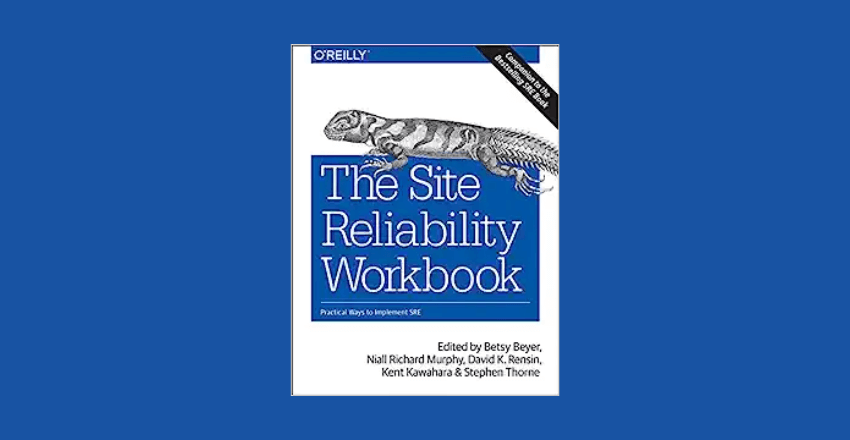Mastering Site Reliability Engineering: A Simple Guide Through the Best Books on SRE

Have you ever experienced a website crash or outage? Perhaps you were trying to purchase concert tickets, and the website crashed due to high traffic.
Or maybe you were trying to access a popular news site during breaking news and couldn’t get through. These kinds of issues can be frustrating, especially when they happen repeatedly.
That’s where Site Reliability Engineering (SRE) comes in. SRE is a discipline that focuses on maintaining and improving complex computing systems’ reliability, availability, and performance.
It involves using software engineering techniques to solve operational problems and ensure systems run smoothly. SRE is essential to the modern tech industry because it ensures users access reliable, uninterrupted services.
The Importance of SRE in the Modern Tech Industry
In today’s digital age, almost every business relies on technology in some way or another. Technology has become integral to our daily lives, from e-commerce sites to social media platforms to cloud-based software solutions.
As a result, ensuring these systems’ reliability and smooth operation has become critical for businesses. SRE provides a structured approach to managing the complexity of modern computing environments.
By leveraging software engineering principles and practices, SRE teams can minimize downtime, reduce costs associated with outages or failures, and improve overall system performance.
One example of why SRE is so essential can be seen in the recent rise of cloud-based services such as Amazon Web Services (AWS) and Microsoft Azure.
These platforms provide businesses with easy-to-use infrastructure components that can be used to build complex applications quickly. However, as more businesses move their operations online, ensuring the reliability and scalability of these services becomes increasingly challenging.
That’s where SRE comes in – it provides a framework for addressing these challenges by focusing on automation, proactive monitoring, and incident management. SRE teams work proactively to prevent issues from occurring before they become significant problems.
They use a structured approach to diagnose and resolve issues quickly, minimizing user impact. SRE is an essential part of the modern tech industry.
It provides a structured approach for managing the complexity of modern computing environments and ensures that systems are reliable and performant. In the following sections, we will explore some of the best books on SRE and how they can help you improve your systems’ reliability and performance.
High-Level Overview of Best Books on SRE
If you’re interested in Site Reliability Engineering, you’re in luck. There are plenty of books out there that can help you become an expert in the field.
This section gives you an overview of the best books on SRE. We’ve chosen these books based on their popularity and their relevance to the topic.
List of Top Books on SRE
- The Site Reliability Workbook by Betsy Beyer et al.
- Site Reliability Engineering: How Google Runs Production Systems by Betsy Beyer et al.
- The DevOps Handbook: How to Create World-Class Agility, Reliability, and Security in Technology Organizations by Gene Kim et al.
- Effective DevOps: Building a Culture of Collaboration, Affinity, and Tooling at Scale by Jennifer Davis and Katherine daniels
The Site Reliability Workbook – Betsy Beyer et al.

This book is a follow-up to Google‘s famous “Site Reliability Engineering” book (which we’ll discuss next). It provides a practical guide for implementing SRE principles in your organization. The book is structured around 37 exercises that help you apply your knowledge to real-world scenarios.
It covers incident response, monitoring systems, capacity planning, and more. This book is perfect for anyone who wants a hands-on approach to learning about SRE.
Site Reliability Engineering: How Google Runs Production Systems – Betsy Beyer et al.
This is one of the most popular books on SRE out there and for a good reason. It’s written by some of the top minds at Google and provides an in-depth look at how the company manages its production systems.
The book covers monitoring and alerting, capacity planning, incident management, and more. It’s an excellent resource for anyone who wants to learn about SRE from one of the pioneers in the field.
The DevOps Handbook: How to Create World-Class Agility, Reliability, and Security in Technology Organizations – Gene Kim et al.
While not explicitly focused on SRE, this book is a must-read for anyone interested in DevOps. It provides a comprehensive guide to creating a high-performing IT organization that can deliver software quickly and reliably.
The book covers continuous delivery, automated testing, metrics-driven development, and more. It’s an excellent resource for anyone who wants to understand how SRE fits into the broader DevOps movement.
Effective DevOps: Building a Culture of Collaboration, Affinity, and Tooling at Scale – Jennifer Davis and Katherine Daniels
This book focuses on one of the most critical aspects of successful SRE implementation: culture. The authors discuss building a collaborative culture that fosters communication and teamwork between development and operations teams.
They also cover automation and tooling, monitoring systems, incident response planning, and more. This is an excellent resource for anyone who wants to develop their skills in these areas.
Deep Dive into Subtopics Covered in the Books
Incident Management and Postmortems: Learning from Failure
In the context of SRE, incident management refers to identifying, responding to, and resolving issues that impact service reliability.
These issues can be anything from code defects to network outages. The goal of incident management is not only to resolve the issue at hand but also to learn from it to prevent similar incidents in the future.
This is where postmortems come into play. A postmortem is a detailed report that outlines what happened during an incident, what steps were taken to resolve it, and what could have been done differently.
The book “Site Reliability Engineering: How Google Runs Production Systems” emphasizes the importance of postmortems in SRE by providing a framework for conducting them effectively.
It suggests that postmortems should be blameless and focus on identifying systemic issues rather than individual mistakes.

Another book on this topic, “The Practice of Cloud System Administration,” by Christine Hogan, Strata R. Chalup, and Thomas A. Limoncelli provides real-world examples of how other organizations have implemented effective incident management and postmortem processes.
Key takeaways from books on incident management and postmortems include emphasizing blamelessness when conducting a postmortem so all team members feel comfortable sharing their thoughts, not just those who were directly involved; creating a culture that values learning from failure as much as success; regularly reviewing past incidents to identify trends or recurring issues; and ensuring that all team members have access to incident information so they can learn from it.
Monitoring and Observability: Keeping a Watchful Eye
Effective monitoring and observability are crucial for SREs to proactively identify potential issues before they become significant problems. Monitoring refers to measuring various metrics related to service performance, such as response times or error rates.
Observability takes monitoring one step further by providing visibility into the internal workings of a system to understand how it operates and where issues might arise.
The book “Effective DevOps: Building a Culture of Collaboration, Affinity, and Tooling at Scale” recommends implementing effective monitoring and observability strategies. One key recommendation is to use metrics that reflect business goals rather than just technical metrics.
Another is to implement distributed tracing to understand dependencies between services better.
Other books on this topic include “Building Secure and Reliable Systems: Best Practices for Designing, Implementing, and Maintaining Systems” which emphasizes the importance of using automated tools for monitoring and alerting, and “The Site Reliability Workbook: Practical Ways to Implement SRE” which suggests setting up dashboards with real-time data on service performance.
Automation and Tooling: The Power of Automation
One of the core principles of SRE is automation. By automating tasks such as deployment or testing, teams can reduce the likelihood of human error while increasing efficiency. Additionally, automation helps ensure consistency across environments.
“The DevOps Handbook: How to Create World-Class Agility, Reliability, & Security in Technology Organizations” provides recommendations for efficiently implementing automation.
It suggests starting small by automating simple tasks like code deployment before moving on to more complex ones like continuous integration/continuous deployment (CI/CD).
Another book on this topic is “Infrastructure as Code: Managing Servers in the Cloud,” which emphasizes using code-based configurations instead of manual interventions.
Recommended tools for automation include Jenkins for CI/CD pipelines; Ansible or Puppet for configuration management; Terraform or CloudFormation for infrastructure provisioning; and AppDynamics or New Relic for application performance monitoring (APM).
Culture and Collaboration: The Importance of People

Despite all the technology involved in SRE practices, one critical factor remains – people. Culture plays a crucial role in the success of SRE implementation. A culture of blamelessness, learning, and collaboration is essential to creating an environment where SREs can thrive.
“The Phoenix Project: A Novel About IT, DevOps, and Helping Your Business Win” guides fostering such a culture. It emphasizes the importance of breaking down silos between teams and promoting cross-functional collaboration.
Another book on this topic is “Accelerate: Building and Scaling High Performing Technology Organizations,” which provides data-driven evidence on how culture affects organizational performance.
Tips for fostering a collaborative culture within an organization include investing in team-building activities; encouraging open communication between teams; emphasizing shared ownership rather than individual ownership; and providing opportunities for continued education and skill-building.
Lesser-known Details from the Books
Case Studies
The books on site reliability engineering provide rich case studies of companies successfully implementing SRE practices. These case studies provide real-world examples of how SRE can help companies achieve their objectives.
For example, “Site Reliability Engineering: How Google Runs Production Systems” discusses how Google’s SRE team manages incidents and postmortems and how they prevent similar incidents from happening in the future.
Another book with a robust collection of case studies is “The Site Reliability Workbook.” In this book, readers will find detailed examples of monitoring and observing complex systems and best practices for automation and tooling. Each case study provides practical insights that readers can apply to their organizations.
Lesser-known Tips
In addition to the extensive coverage of SRE best practices, these books contain lesser-known tips that can be applied to take your organization’s SRE practices to the next level. For example, “Effective DevOps” argues that a critical aspect of successful SRE implementation is aligning everyone in your organization around a common goal.
This means breaking down silos between teams and fostering a culture of collaboration. Another tip comes from “Site Reliability Engineering: How Google Runs Production Systems.” The book recommends establishing an Error Budget Policy (EBP), which helps organizations balance innovation with reliability by setting thresholds for acceptable downtime or service disruptions.
Conclusion
Many excellent books on site reliability engineering cover all aspects of implementing successful SRE practices in an organization.
From incident management and postmortems to monitoring and observability, automation and tooling, and culture and collaboration – these books provide practical advice based on real-world experiences.
By reading these books and implementing their recommendations within your organization, you can improve your SRE practices and achieve excellent reliability, scalability, and innovation.
So, whether you’re just starting with SRE or looking to take your organization’s practices to the next level, these books are an invaluable resource to help you achieve your goals.
Noah is an accomplished technical author specializing in Operations and DevOps, driven by a passion ignited during his tenure at eBay in 2000. With over two decades of experience, Noah shares his transformative knowledge and insights with the community.
Residing in a charming London townhouse, he finds inspiration in the vibrant energy of the city. From his cozy writing den, overlooking bustling streets, Noah immerses himself in the evolving landscape of software development, operations, and technology. Noah’s impressive professional journey includes key roles at IBM and Microsoft, enriching his understanding of software development and operations.
Driven by insatiable curiosity, Noah stays at the forefront of technological advancements, exploring emerging trends in Operations and DevOps. Through engaging publications, he empowers professionals to navigate the complexities of development operations with confidence.
With experience, passion, and a commitment to excellence, Noah is a trusted voice in the Operations and DevOps community. Dedicated to unlocking the potential of this dynamic field, he inspires others to embrace its transformative power.







